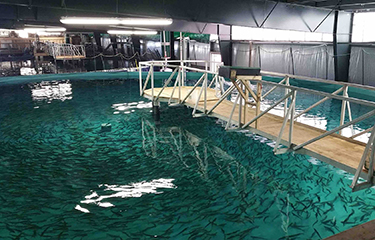Land-based salmon aquaculture facilities utilizing recirculating aquaculture systems have been a growing topic of interest in the seafood industry.
Between Nordic Aquafarm’s planned facilities in both Belfast, Maine and Humboldt County, California; Whole Ocean’s plans for a facility in Bucksport, Maine; and Atlantic Sapphire’s facility in Miami, Florida, the RAS method for growing salmon is poised to become a breakthrough technology. Production numbers from all four, using the low end of company estimates, would amount to nearly 120,000 metric tons of salmon a year.
Cape d’Or salmon, located in Advocate Harbour, Nova Scotia, Canada may be on a smaller scale than the aforementioned projects, but its success over the past five years has proven that a RAS model can work.
“They started growing salmon around five years ago slowly,” Stefan LeBrun, sales and customer relations for Cape d’Or, told SeafoodSource.
“They” are Paul and Gloria Merlin, founder and co-founder of the business, along with Forrest Merlin, the president and CEO.
Cape d’Or uses an RAS system to produce both salmon and halibut in its closed-containment, land-based system. The company’s salmon are raised from the egg in a hatchery before moving on to grow-out in the company’s facility.
One unique characteristic of Cape d’Or is the company’s use of saltwater, rather than freshwater, in its facilities.
“They actually are able to have biosecure saltwater wells,” LeBrun said. The facility is located in close proximity to the ocean in Advocate Harbour, allowing the company to source saltwater that has been filtered through the local beach.
“We’ve found that it provides a superior-tasting fish, raising that way, as opposed to raising them in fresh water and trying to add salinity,” Lebrun said.
In addition to being land-based, the farm was recently certified to Canadian organic standards by Global Trust (SAI Global), making it one of the few certified organic land-based salmon farms in the world. That accomplishment was achieved using a custom diet the company sources from Skretting, according to LeBrun.
“Our feed is based on a sustainable fish source, and it’s more authentic to what salmon would eat in the wild,” he said.
Of course, growing salmon on land as opposed to more traditional forms of ocean aquaculture had its challenges, not the least of which is the additional costs associated with the upkeep of the equipment needed to keep the facility working. Despite that, Cape d’Or has managed to steadily increase production.
“We have grown from about doing 100,000 pounds a year in the early days, to this year doing about 500,000 pounds,” LeBrun said.
And business is solid. That 500,000 pounds is mostly already spoken for, LeBrun said.
“It appears this year that we’re going to have a demand that will exceed the supply,” LeBrun said.
A lot of the fish is being sold as head-on, gutted, LeBrun added.
“We are doing a little bit of fillets and portions, but we find especially with shipping the biggest demand is head-on, gutted,” he said. “The fish hold up well when they’re shipped in that fashion.”
Future goals for the company, LeBrun said, is honing in a consistent supply of fish, and continuing to provide a high-quality, organic product via RAS.
“It absolutely can be done, it’s certainly not without its challenges,” he said. “There is a market for this fish, and you can grow it successfully.”
Photo courtesy of Cap d'Or







